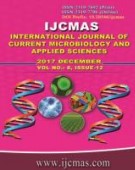


 National Academy of Agricultural Sciences (NAAS)
National Academy of Agricultural Sciences (NAAS)

|
PRINT ISSN : 2319-7692
Online ISSN : 2319-7706 Issues : 12 per year Publisher : Excellent Publishers Email : editorijcmas@gmail.com / submit@ijcmas.com Editor-in-chief: Dr.M.Prakash Index Copernicus ICV 2018: 95.39 NAAS RATING 2020: 5.38 |
Soil microbes play an important role in major processes of soil system. Rapid, reliable and cost effective assessment of soil microbiological properties is highly essential for monitoring soil health. Traditional chemical-based soil analysis is laborious, hazardous and time consuming. Visible near-infrared (VIS-NIR) reflectance spectroscopy can be a viable alternative to ensure rapid and environmentally safe soil test results. With this objective, two key soil microbiological parameters microbial biomass carbon (MBC) and dehydrogenase activity (DHA) were examined for their amenability to diffuse reflectance spectroscopy assessment. Geo referenced surface soil (0-15cm) samples (n=170) were collected from different fields for spectral analysis. Partial least square regression (PLSR) technique was employed for developing spectral models. The different model evaluation indices like coefficient of determination (R2), root mean square error of prediction (RMSE) and ratio of performance deviation (RPD) were used to evaluate the predictive performance of model. The RPD values for MBC and DHA were 1.15 and 1.13. Poor predictive performance of our model as opposed to substantial evidence in literature can be ascribed to range of factors like limited variability in spectra, relatively smaller sample size, use of entire spectra instead of selective regions and use of samples collected under natural farm environment as opposed to those generated under controlled conditions.
 |
 |
 |
 |
 |